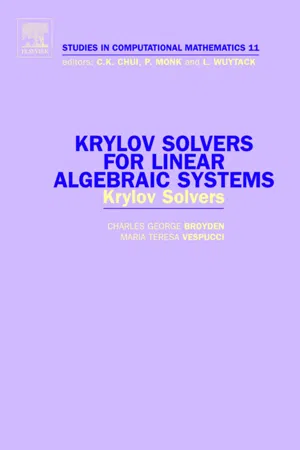
Krylov Solvers for Linear Algebraic Systems
Krylov Solvers
- 342 pages
- English
- PDF
- Available on iOS & Android
Krylov Solvers for Linear Algebraic Systems
Krylov Solvers
About this book
The first four chapters of this book give a comprehensive and unified theory of the Krylov methods. Many of these are shown to be particular examples ofthe block conjugate-gradient algorithm and it is this observation thatpermits the unification of the theory. The two major sub-classes of thosemethods, the Lanczos and the Hestenes-Stiefel, are developed in parallel asnatural generalisations of the Orthodir (GCR) and Orthomin algorithms. Theseare themselves based on Arnoldi's algorithm and a generalised Gram-Schmidtalgorithm and their properties, in particular their stability properties, are determined by the two matrices that define the block conjugate-gradientalgorithm. These are the matrix of coefficients and the preconditioningmatrix.In Chapter 5 the"transpose-free" algorithms based on the conjugate-gradient squared algorithm are presented while Chapter 6 examines the various ways in which the QMR technique has been exploited. Look-ahead methods and general block methods are dealt with in Chapters 7 and 8 while Chapter 9 is devoted to error analysis of two basic algorithms.In Chapter 10 the results of numerical testing of the more important algorithms in their basic forms (i.e. without look-ahead or preconditioning) are presented and these are related to the structure of the algorithms and the general theory. Graphs illustrating the performances of various algorithm/problem combinations are given via a CD-ROM.Chapter 11, by far the longest, gives a survey of preconditioning techniques. These range from the old idea of polynomial preconditioning via SOR and ILU preconditioning to methods like SpAI, AInv and the multigrid methods that were developed specifically for use with parallel computers. Chapter 12 is devoted to dual algorithms like Orthores and the reverse algorithms of Hegedus. Finally certain ancillary matters like reduction to Hessenberg form, Chebychev polynomials and the companion matrix are described in a series of appendices.·comprehensive and unified approach·up-to-date chapter on preconditioners·complete theory of stability·includes dual and reverse methods·comparison of algorithms on CD-ROM·objective assessment of algorithms
Frequently asked questions
- Essential is ideal for learners and professionals who enjoy exploring a wide range of subjects. Access the Essential Library with 800,000+ trusted titles and best-sellers across business, personal growth, and the humanities. Includes unlimited reading time and Standard Read Aloud voice.
- Complete: Perfect for advanced learners and researchers needing full, unrestricted access. Unlock 1.4M+ books across hundreds of subjects, including academic and specialized titles. The Complete Plan also includes advanced features like Premium Read Aloud and Research Assistant.
Please note we cannot support devices running on iOS 13 and Android 7 or earlier. Learn more about using the app.
Information
Table of contents
- Front Cover
- Krylov Solvers for Linear Algebraic Systems
- Copyright Page
- Preface
- Contents
- Chapter 1. Introduction
- Chapter 2. The long recurrences
- Chapter 3. The short recurrences
- Chapter 4. The Krylov aspects
- Chapter 5. Transpose-free methods
- Chapter 6. More on QMR
- Chapter 7. Look-ahead methods
- Chapter 8. General block methods
- Chapter 9. Some numerical considerations
- Chapter 10. And in practice...?
- Chapter 11. Preconditioning
- Chapter 12. Duality
- Appendix A. Reduction of upper Hessenberg matrix to upper triangular form
- Appendix B. Schur complements
- Appendix C. The Jordan Form
- Appendix D. Chebychev polynomials
- Appendix E. The companion matrix
- Appendix F. The algorithms
- Appendix G. Guide to the graphs
- References
- Index